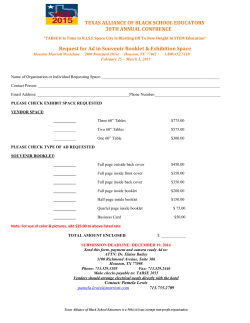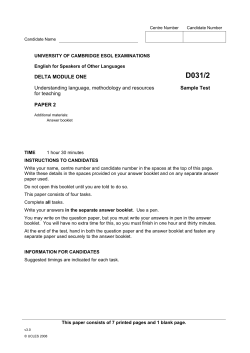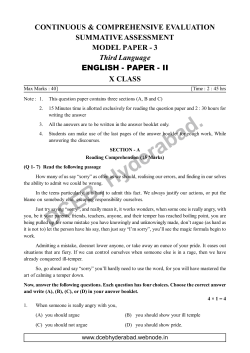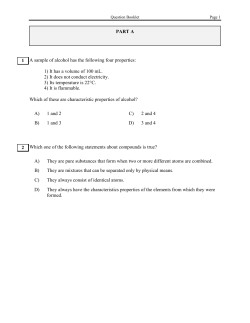
Physical Development Requirements The physical development of babies and
Learning and Development The Early Years Foundation Stage Physical Development Requirements The physical development of babies and young children must be encouraged through the provision of opportunities for them to be active and interactive and to improve their skills of coordination, control, manipulation and movement. They must be supported in using all of their senses to learn about the world around them and to make connections between new information and what they already know. They must be supported in developing an understanding of the importance of physical activity and making healthy choices in relation to food. Aspects of Physical Development What Physical Development means for children Physical Development is made up of the following aspects: Movement and Space – is about how children learn to move with confidence, imagination and safety, with an awareness of space, themselves and others. ■ abies and children learn by being active and B Physical Development takes place across all areas of Learning and Development. ■ hysical Development helps children gain P confidence in what they can do. ■ hysical Development enables children to feel P the positive benefits of being healthy and active. ■ hysical Development helps children to develop P a positive sense of well-being. ■ ood health in the early years helps to G safeguard health and well-being throughout life. It is important that children develop healthy habits when they first learn about food and activity. Growing with appropriate weight gain in the first years of life helps to guard against obesity in later life. Health and Bodily Awareness – is about how children learn the importance of keeping healthy and the factors that contribute to maintaining their health. Using Equipment and Materials – is about the ways in which children use a range of small and large equipment. Personal, Social and Emotional Development Creative Development Communication, Language and Literacy Physical Development Problem Solving, Reasoning and Numeracy Knowledge and Understanding of the World Positive Relationships ■ uild children’s confidence to take manageable B risks in their play. ■ otivate children to be active and help them M develop movement skills through praise, encouragement, games and appropriate guidance. ■ ■ otice and value children’s natural and N spontaneous movements, through which they are finding out about their bodies and exploring sensations such as balance. rovide time to support children’s understanding P of how exercise, eating, sleeping and hygiene promote good health. Enabling Environments ■ Provide equipment and resources that are sufficient, challenging and interesting and that can be used in a variety of ways, or to support specific skills. ■ Allow sufficient space, indoors and outdoors, to set up relevant activities for energetic play. ■ Provide time and opportunities for children with physical disabilities or motor impairments to develop their physical skills, working in partnership with relevant specialists such as physiotherapists and occupational therapists. ■ Use additional adult help, as necessary, to support individuals and to encourage increased independence in physical activities. Learning and Development ■ Plan activities that offer physical challenges and plenty of opportunities for physical activity. ■ Give sufficient time for children to use a range of equipment to persist in activities, practising new and existing skills and learning from their mistakes. ■ Introduce appropriate vocabulary to children, alongside their actions. ■ Treat mealtimes as an opportunity to promote children’s social development, while enjoying food and highlighting the importance of making healthy choices. What do I do next? The Early Years Foundation Stage Setting the Standards for Learning, Development and Care for children from birth to five 00012-2007CDO-EN ISBN: 978-1-84478-886-6 © Crown copyright 2007 OK Media 02-2007 ISBN 978-1-84478-886-6 • Welfare requirements are explained in full in the Statutory Framework for the Early Years Foundation Stage booklet. • CD tatum ming eu feum bla feuiscin henis nulput effective • Areas of Learning andquisi Development including practice, planning and resourcing at different stages are detailed aciliquisse. in• the Practice for the Years Foundation Stage G rids con Guidance et nit veliquat duisEarly essectem niat, booklet and on the CD-ROM. conum at, quatuer iurerosto is corper irit lor ero • Early Support information available onsequississit the CD-ROM odoloreros delit. and Development. under areas ofnim Learning •R esearch and resources are available on the CD-ROM. 00012-2007DOM-EN © Crown copyright 2007 How settings can effectively implement this area of Learning and Development To give all children the best opportunities for effective development and learning in Physical Development practitioners should give particular attention to the following areas.
© Copyright 2025





















